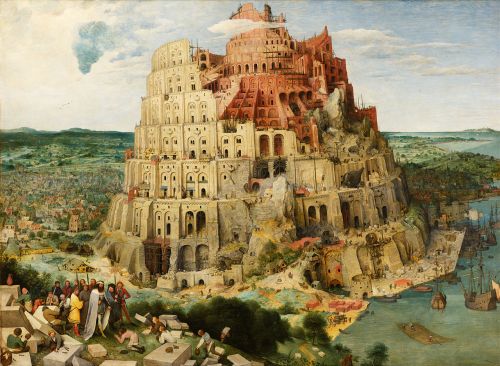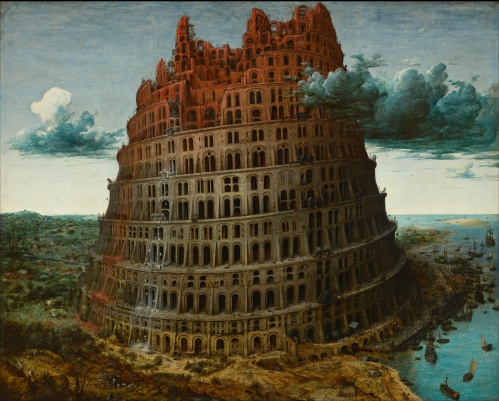Eco: Search for the Perfect Language, 2.

Pieter Brueghel the Elder (1526/1530-1569 CE), The Tower of Babel. Brueghel painted three versions of the Tower of Babel. One is kept in the Museum Bojimans Van Beuningen in Rotterdam, the second, this one, is held in the Kunsthistoriches Museum in Vienna, while the disposition of the third version, a miniature on ivory, is unknown. Faithful reproductions of two-dimensional public domain works of art are public domain.
“Beyond this, I have decided to consider only projects concerning true and proper languages. This means that, with a bitter sigh of relief, I have decided to consider only the following:
- the rediscovery of languages postulated as original or as mystically perfect — such as Hebrew, Egyptian or Chinese;
- the reconstruction of languages postulated, either fancifully or not, as original or mother tongues, including the laboratory model of Indo-European;
- languages constructed artificially for one of three ends: (a) perfection in terms of either function or structure, such as the a priori philosophical languages of the seventeenth and eighteenth centuries, which were designed to express ideas perfectly and to discover thereby new connections between the diverse aspects of reality; (b) perfection in terms of universality, such as the a posteriori international languages of the nineteenth century; (c) perfection in terms of practicality, if only presumed, such as the so-called polygraphies;
- more or less magic languages, whether they be discovered or fabricated, whose perfection is extolled on account of either their mystic affability or their initiative secrecy.
By contrast, I can give no more than bare notice to any of the following:
- oneiric languages, not expressly invented, such as the languages of the insane, or of trance states, or of mystic revelations (like the Unknown Language of Saint Hildegarde of Bingen), as well as all the cases of glossolalia or xenoglossia (cf. Samara 1972); Goodman 1972);
- fictitious languages, either in narrative (from Rabelais to Foigny up to Orwell’s ‘Newspeak’ and Tolkien), or in poetry (like Chlebnikov’s transmental speech). In the majority of these cases, we are presented with only short stretches of speech, supposedly representing an actual language, for which, however, there is provided neither a lexicon nor a syntax (cf. Pons 1930, 1931, 1932, 1979; Yaguello 1984).
- bricolage languages, that is languages that are created spontaneously by the encounter of two linguistically distinct cultures. Typical examples are the pidgins arising in areas of colonialism. As cross-national as they may be, they are not universal. They are, rather, partial and imperfect because they have a limited lexicon and an oversimplified syntax; they are used to facilitate simple activities such as barter, but are unable to express higher types of experience (cf. Waldman 1977);
- natural tongues or jargons serving as vehicular languages in multilingual zones. An example of such a language of exchange might be Swahili, the lingua franca of large areas of East Africa. Modern English would be another example. French was formerly an example, if one considers that, during the Convention, the Abbé Gregoire revealed that, out of a population of twenty-six million, fifteen million French men and women spoke a language other than that of Paris (Calvet 1981: 110);
- formal languages whose use is limited to special scientific purposes, such as the languages of chemistry, algebra and logic (these will be considered only as they derive from projects defined by category 3(a) above;
- the immense and delectable category of the so-called fous du language (see, for example, Blavier 1982; Yaguello 1984). Admittedly, in such cases it is not always easy to distinguish between technical insanity and mild glottomania, and many of my own characters may sometimes show some aspects of lunacy. Still, it is possible to make a distinction. We will not consider belated glottomaniacs. Nevertheless, I have not always been able to keep down my taste for whimsicality, especially when (even though the belatedness was hardly justifiable) those attempts had, anyway, a certain, traceable, historic influence, or, at least, they documented the longevity of a dream.
Similarly, I do not claim here to examine the whole of the researches on a universal grammar (except in cases in which they clearly intersect with my topic), because they deserve a separate chapter of the history of linguistics.
Likewise, this is not (except, again, where the subject intersects with that of the perfect language) a book about the secular, or rather, millennial, question of the origins of language.
There are infinite discussions on the origins of human language which do not consider the possibility or the opportunity of returning back to the language of our origins, either because they assume that it had definitely disappeared, or because they consider it as radically imperfect.
Finally, were it up to me to decide under which heading this book should be filed in a library catalogue (an issue which, for Leibniz, was bound up with the problem of a perfect language), I would pick neither ‘linguistics’ nor ‘semiotics’ (even though the book employs semiotics as its instrument, and demands a certain degree of semiotic interest from its reader).
I would rather pick ‘history of ideas.’ This explains why I make no attempt to construct a rigorous semiotic typology for the various types of a priori and a posteriori languages: this would require a detailed examination of each and every project, a job for students of what is now called ‘general inter linguistics.’
The present book aims instead at delineating, with large brushstrokes and selected examples, the principle episodes of the story of a dream that has run now for almost two thousand years.”
Umberto Eco, The Search for the Perfect Language, translated by James Fentress, Blackwell. Oxford, 1995, pp. 2-5.


May 11, 2016
Eco: The Nationalistic Hypothesis
Athanasius Kircher (1602-80), an excerpt from p. 157 of Turris Babel, Sive Archontologia Qua Priscorum post diluvium hominum vita, mores rerumque gestarum magnitudo, Secundo Turris fabrica civitatumque exstructio. confusio linguarum, & inde gentium transmigrationis, cum principalium inde enatorum idiomatum historia, multiplici eruditione describuntur & explicantur. Amsterdam, Jansson-Waesberge, 1679. A table portraying ancient alphabets, in which Kircher asserts that modern alphabets resemble ancient versions. Courtesy of Stanford University. This work is in the public domain in its country of origin and other countries and areas where the copyright term is the author’s life plus 100 years or less.
“Another alternative was to accept that Hebrew had been the original perfect language, but to argue that, after the confusio, the crown of perfection had been bestowed upon other languages.
The first text which countenances this sort of “nationalistic” reconstruction of linguistic history is the Commentatio super opera diversorum auctorum de antiquitatibus loquentium of 1498 by Giovanni Nanni, or Annius, which tells how, before it was colonized by the Greeks, Etruria had been settled by Noah and his descendants.
Nanni is here reflecting on the contradiction between Genesis 11, the story of Babel, and Genesis 10. In 10:5, the sons of Japheth settle the “isles of the Gentiles . . . every one after his tongue.”
The notion of a lineage ascending from modern Tuscan through Etruscan to the Aramaic of Noah was elaborated in Florence by Giovann Battista Gelli (Dell’origine di Firenze, 1542-4), and by Piero Francesco Giambullari (Il Gello, 1564).
Their thesis, fundamentally anti-humanist, accepted the idea that the multiplication of tongues had preceded Babel (citing what Dante had had to say in Paradise, xxvi).
This thesis was passionately received by Guillaume Postel, who, we have seen, had already argued that Celtic had descended from Noah. In De Etruriae regionis (1551) Postel embraced the position of Gelli and Giambullari concerning the relationship of the Etruscan to Noah, qualifying it, however, by the claim that the Hebrew of Adam had remained–at least in its hieratic form–uncontaminated throughout the centuries.
More moderate were the claims of Spanish Renaissance authors. The Castilian tongue too might claim descent from one of Japheth’s many sons–in this case Tubal. Yet it was still only one of the seventy-two languages formed after Babel.
This moderation was more apparent than real, however, for, in Spain, the term “language of Babel” became an emblem of antiquity and nobility (for Italian and Spanish debates, cf. Tavoni 1990).
It was one thing to argue that one’s own national language could claim nobility on account of its derivation from an original language–whether that of Adam or that of Noah–but quite a different matter to argue that, for this reason, one’s language ought to be considered as the one and only perfect language, on a par with the language of Adam.
Only the Irish grammarians cited in the first chapter and Dante had had, so far, the audacity to arrive at such a daring conclusion (and even Dante–who had aspired to create a perfect language from his own vernacular–made sarcastic remarks on those who consider their native language as the most ancient and perfect: cf. DVE, I, vi).
By the seventeenth century, however, linguistic nationalism had begun to bud; this prompted a plethora of such curious claims.
Goropius Becanus (Jan van Gorp) in his Origins Antwerpianae of 1569 agreed with all claims made about the divine inspiration of the original language, and about its motivated and non-arbitrary relation between words and things.
According to him there was only a single living language in which this motivated concordance existed to an exemplary degree; that language was Dutch, particularly the dialect of Antwerp.
The ancestors of the burghers of Antwerp were the Cimbri, the direct descendants of the sons of Japheth. These had not been present under the Tower of Babel, and, consequently, they had been spared the confusio linguarum.
Thus they had preserved the language of Adam in all its perfection. Such an assertion, Becanus claimed, could be proved by etymological demonstrations. He produced a string of arguments whose level of etymological wishful thinking matched those of Isidore and Guichard; they later became known as “becanisms” or “goropisms.”
Becanus further claimed that his thesis was also proved by the facts that the Dutch had the highest number of monosyllabic words, possessed a richness of sounds superior to all other languages, and favored in the highest degree the formation of compound words.
Becanus‘ thesis was later supported by Abraham Mylius (Lingua belgica, 1612) as well as by Adrian Schrickius (Adversariorum Libri III, 1620), who wished to demonstrate “that Hebrew was divine and firstborn” and “that Teutonic came immediately afterwards.”
Teutonic here meant the Dutch spoken in Antwerp, which, at the time, was its best-known dialect. In both cases, the demonstration was supported by etymological proofs little better than those of Becanus.”
Umberto Eco, The Search for the Perfect Language, translated by James Fentress, Blackwell. Oxford, 1995, pp. 95-7.
Share this: